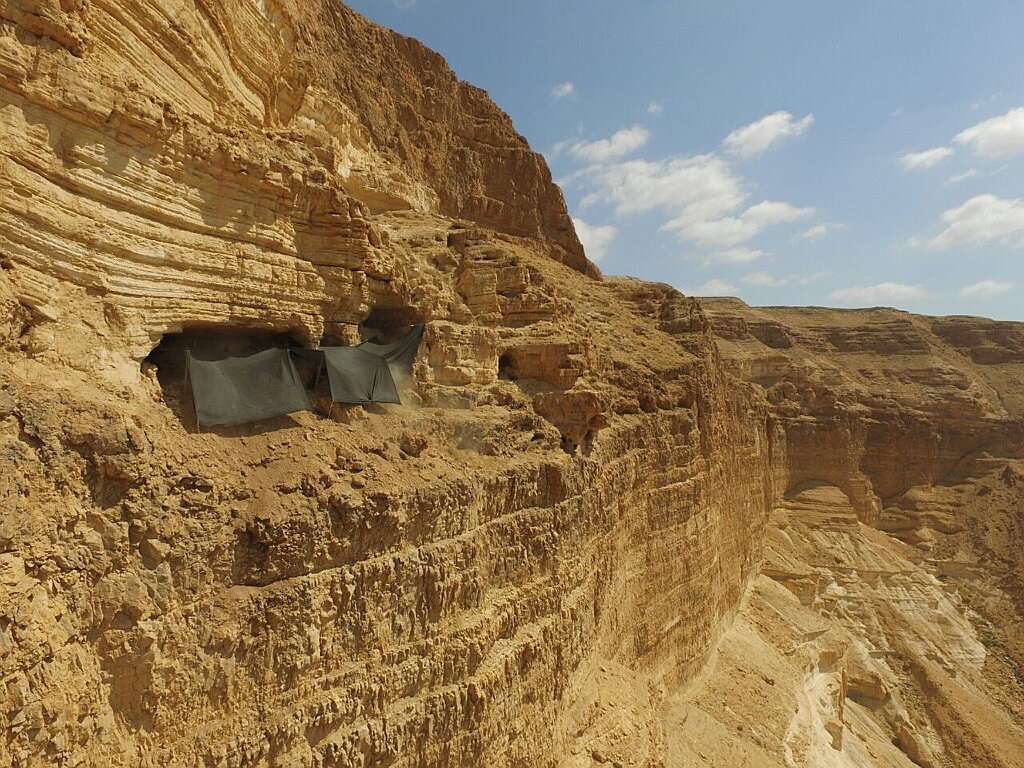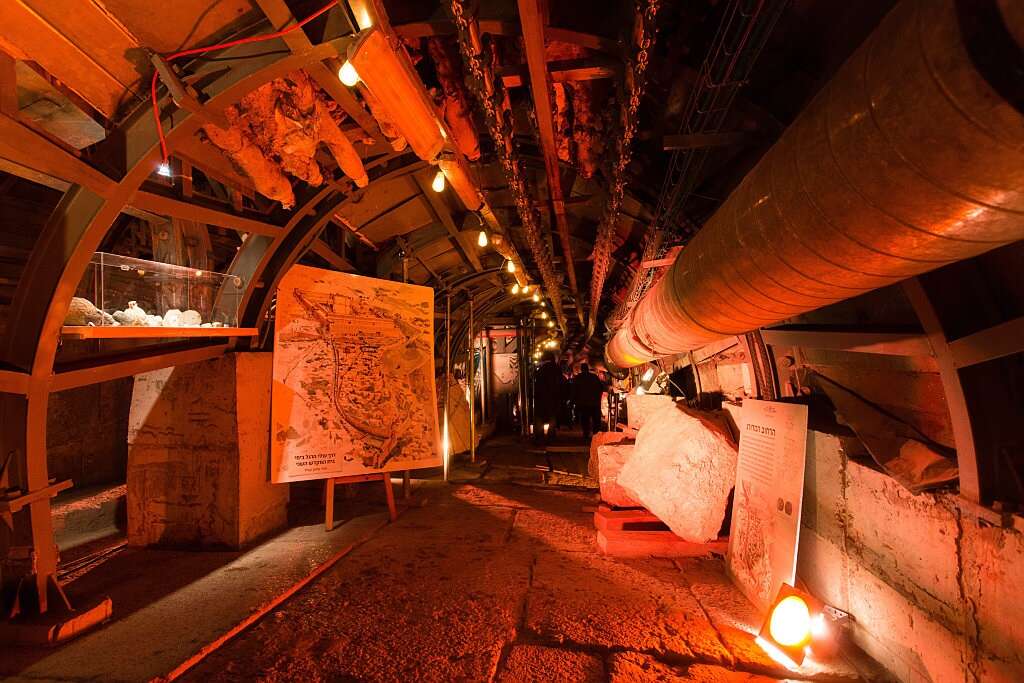In archaeology, a tiny fragment of a millennia-old inscription can solve centuries-old questions about people and places. So in a country where every infrastructure project is preceded by an exploratory dig to rule out any possibility of a treasure trove from the past being forever sealed by a new highway or building, in a decade where discoveries range from ancient grains to a 9,000-year-old mask to rusty weapons left over from World War I, how can we zero in on only the FIVE most important finds?
Spoiler – We can't. What we can offer you is our pick of the coolest developments in Israeli archaeology over the past 10 years. So let's hop into the trenches and dig in:
So you're jogging with your dog through a wooded area of the Neve Yaakov neighborhood in northeast Jerusalem and all of a sudden, you see a 1,400-year-old wine press that definitely hadn't been there before.
5: Ancient wine press appears out of nowhere
The Israel Antiquities Authority was a little surprised, to say the least, when an archaeologically minded resident called in her find in May 2015, because none of its people were excavating in the area. But the IAA team dispatched to investigate discovered that the wine press had been discovered by a group of teenagers who were self-professed "archaeology buffs" who had taken it upon themselves to carefully excavate the site.

The archaeologists praised their careful work. "The story touched our hearts and reminded us of our own childhoods," said IAA archaeologist Amit Re'em. However, the Authority gently suggested that in the future, the young archaeologists call in professionals, as "non-methodic" work can damage ancient artifacts. Oh, and the teens were invited to put their talents to use as volunteers on official IAA digs.
In the 1950s, researchers and a group of Bedouin discovered a trove of tens of thousands of scraps of parchment and papyrus comprising parts of about 1,000 manuscripts that had been inscribed 2,000 years earlier. Because of their small size and delicate condition, many of the fragments were stored in cigar boxes and shelved.
4: The Dead Sea Scrolls -Maybe NASA can help?
The Israel Antiquities Authority has long aimed to make the content of the Dead Sea scrolls, as they became known, available to all through the internet. Great! But what to do about the many fragments, some minuscule, of the scrolls that have yet to be decoded?
In 2018, the IAA brought in the big guns and used special imaging technology developed for none other than NASA to shed new light on some of the scrolls.

One section written in proto-Hebrew did not appear to belong to any of the 1,000 manuscripts known today, causing researchers to wonder if there were parts of the Dead Sea Scrolls that had never been discovered.
The NASA technology even raised the tantalizing prospect that there could be an entire additional Dead Sea Scroll whose existence was unknown!
In 2018, archaeologists excavating the Raqefet Cave in the Mount Carmel region near Haifa discovered evidence that beer was brewed there 13,000 years ago – the earliest example of alcohol production found to date.
3: 'Drinking the dinosaurs' - Beer 13,000 years ago and today
The researchers, a joint team from the University of Haifa and Stanford University in California, found traces of beer that was brewed in the cave by the Natufian people, who lived between 15,000 and 11,500 years ago and were among the first people in the world to abandon a nomadic way of life. The Mount Carmel settlement was one of the most important Natufians communities, and researchers from the University of Haifa have been studying the Natufian sites on and around the Carmel for decades.
"They made beer and drank it, apparently as part of special ceremonies," explained Professor Dani Nadel of the Zinman Institute of Archaeology at the University of Haifa.
But why stop there? In theory, yeast that was good enough to brew beer back in the day should still do the job. In 2019, that theory became practice when Israeli researchers raised a glass to celebrate a long-brewing project of making beer and mead using yeasts extracted from ancient clay vessels – some over 5,000 years old.

Archaeologists and microbiologists from the Israel Antiquities Authority and four Israeli universities teamed up to study yeast colonies found in microscopic pores in pottery fragments from Egyptian, Philistine, and Judean archaeological sites in Israel spanning from 3,000 BCE to the fourth century BCE.
Scientists are touting the brews made from "resurrected" yeasts as an important step in experimental archaeology, a field that seeks to reconstruct the past in order to better understand the flavor of the ancient world.
"In Jurassic Park, the dinosaurs eat the scientists," he said. "Here, the scientists drink the dinosaurs," said Aren Maeir, an archaeologist from Bar-Ilan University.
2: Stop, thief! Antiquities Authority inspectors nab robbers in the act
This past decade has seen some Indiana Jones-like derring-do on the part of Israeli authorities who are doing battle with modern-day antiquities thieves. According to Amir Ganor, who heads the Antiquities Robbery Prevention Unit at the IAA, explained that bands of robbers have been operating in the Judean Desert for years, looking for objects that they sell for hefty profits.

In 2014, a group of robbers who were trying to sneak ancient scrolls and artifacts out of a cave in the Judean Desert were nabbed in the act – the first time antiquities robbers had been caught in 30 years. The would-be thieves were spotted by members of a desert search and rescue team that was on training maneuvers. The first responders contacted the Israel Antiquities Authority, who rushed to the site.
The suspects, Arabs from a village near Hebron, were digging illegally at a site archaeologists know as the Cave of Skulls and had already caused major damage by the time they were apprehended.
Artifacts found in their possession included a 2,000-year-old lice comb.
In the summer of 2019, US Ambassador to Israel David Friedman attended an unveiling ceremony for new sections of the Pilgrim's Road in the Old City of Jerusalem, which archaeologists have been excavating for the past six years.
1: An ancient route leading to the Second Temple is excavated, revealing surprises
The Herodian road, which was traversed by pilgrims on their way to the Second Temple, was rediscovered by archaeologists in 1894. The excavated sections now run for 700 meters (2,300 feet), from the Pool of Siloam in central Silwan to the slopes of the southern corner of the Western Wall.

But the name "Herodian road" is misleading, as King Herod apparently had nothing to do with its construction. In fact, research published a few months after Friedman and former Trump advisor Jason Greenblatt attended the unveiling of the latest sections of the road indicates that it was most likely built by none other than the infamous Roman governor of Judea, Pontius Pilate.
More than 100 coins found beneath the ancient road prove it must have been completed between 31 and 40 CE, a period mostly covered by Pilate's governorship, Dr. Donald Ariel of the IAA explained.
Ariel suggested the possibility that Pilate had the street built to reduce tensions between the Romans and the Jewish population.
It will likely take another five years or so of work to dig out the full length of the Pilgrim's Road, and who knows what treasures will be revealed along the way?




